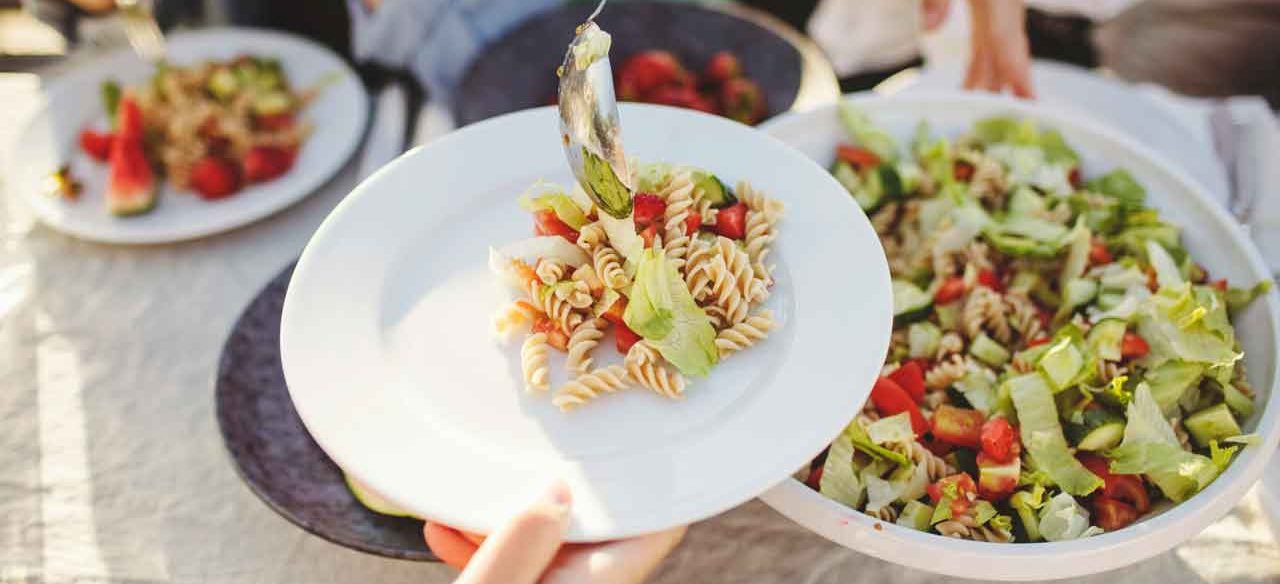What Is One Serving Size?

What is one serving size of chicken? It’s about the size of a bar of soap. But Americans tend to serve and eat bigger portions, especially in restaurants.
What is one serving size of pasta? A half-cup, which should look about the size of a computer mouse on your plate. How about leafy greens? Cooked rice?
Unless you cook or think carefully about portions, you may not realize how much you’re eating or serving your family. The serving sizes you’ll see on nutritional labels come from recommendations from government agencies — the Dietary Guidelines for Americans put out jointly by the United States Department of Agriculture and Department of Health and Human Services.
The terms serving and portion, the amount of food manufacturers and restaurants recommend you eat, are often used interchangeably, but there is no difference between them.
YOU MIGHT ALSO LIKE: Our Nutrition section
Over the years, Americans have been eating more and becoming overweight and obese. About a third of our daily calories come from food prepared outside the home, and standard portions have boomed. A tub of popcorn contains 360 more calories than it did years ago. That’s why it’s a good idea to share it.
The chart below compares standard portions two decades ago and now.
Comparison of portions and calories 20 years ago to now
| 20 Years Ago | Today | ||
Portion | Calories | Portion | Calories | |
Bagel | 3" diameter | 140 | 6" diameter | 350 |
Cheeseburger | 1 | 333 | 1 | 590 |
Spaghetti w/meatballs | 1 cup sauce 3 small meatballs | 500 | 2 cups sauce, 3 large meatballs | 1,020 |
Soda | 6.5 ounces | 82 | 20 ounces | 250 |
Blueberry muffin | 1.5 ounces | 210 | 5 ounces | 500 |
On the second line of the chart, you’ll see that a cheeseburger today has 257 more calories than in the past. If you weigh 130 pounds it might take you 90 minutes of lifting weights to burn those extra calories.
To fight back, don’t finish the meals you’re served
A steak in a restaurant could fill up your plate, but you don’t need more than three ounces, which would be about the size of a bar of soap.
In general, restaurant plates arrive with enough food for two or even three people, so plan on sharing or bringing food home for later. If no one wants to share, since Americans tend to overeat, you may be eating much less than the people around you.
Try to eat slowly and focus on the conversation and the flavors of the food, so you fully enjoy your experience and eat less. Think about the savings and pleasure of enjoying a second meal of restaurant food at home.
Measure the portions on your plate
Especially if you’re starting a weight loss program, take the time to measure out healthful portions of various foods and study what they look like. You’ll be aiming for at least five servings of fruits and veggies daily.
One serving of fruit might be an apple or peach the size of a tennis ball. One serving of broccoli might be the size of a baseball.
But when it comes to leafy greens, go for an entire cup, about the size of two baseballs.
What is one serving size of starches? If you’re eating cooked rice or oatmeal, you don’t need more than a half cup — the size of the bulb in a lightbulb. A half cup of cooked pasta shouldn’t be bigger than a computer mouse. A half cup of cooked beans makes one serving, which wouldn’t be bigger than a baseball.
A serving of hard cheese shouldn’t be more than an ounce, which might look like three stacked dice. A teaspoon of butter is no bigger than a postage stamp.
Aim for a soap-sized portion of chicken or other meat. Three ounces of fish might look like a checkbook.
If you’re having peanut butter on a sandwich, stick to two tablespoons, which is about the size of a ping pong ball. An ounce of nuts also would also be about the size of a ping pong ball.
Updated:
May 24, 2023
Reviewed By:
Janet O’Dell, RN